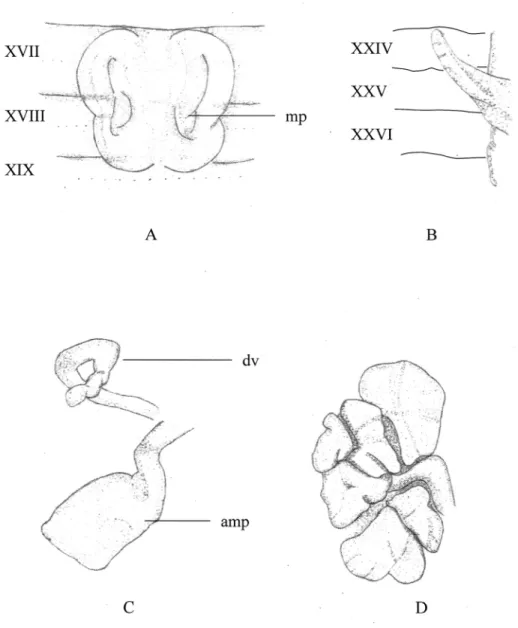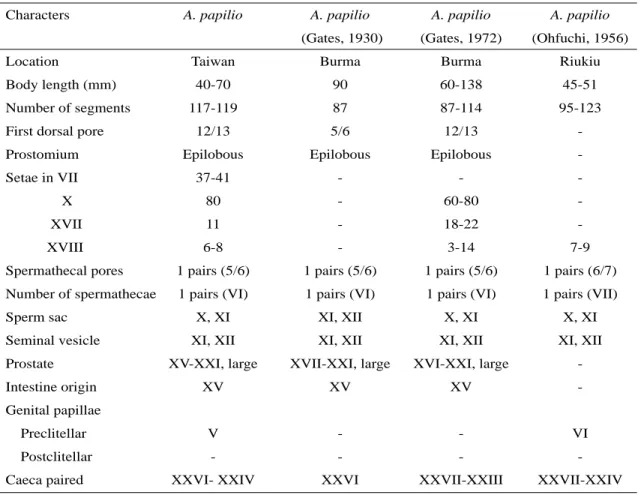A New Record of the Bithecal Megascolecid Earthworm
Amynthas papilio (Gates) (Oligochaeta) from Taiwan
台 灣 一 對 受 精 囊 之 新 紀 錄 種 蚯 蚓
Amynthas papilio (Gates)
Jiun-Hong Chen and Shu-Chun Chuang
Institute of Zoology, National Taiwan University, Taipei , Taiwan
台灣大學動物學研究所 台北市羅斯福路四段1號
陳俊宏 莊淑君
Abstract
This paper reports a new record of the megascolecid earthworm Amynthas papilio (Gates, 1930) from Taiwan. It was originally described from Burma, and also reported from the Riukiu Islands of Japan. In our recent earthworm survey in the northern Taiwan, A. papilio was collected in the grass fields with rich soil at the campus of National Taiwan University and Hsin-Chu Girl High School. As it occurs at human disturbed habitat associated with urbanization, we suspect it as an exotic species introduced recently from Southeast Asia.
摘
要
本文描述一巨蚓科(family Megascolecidae) 台灣新紀錄種蚯蚓Amynthas papilio (Gates, 1930)。 此種蚯蚓首次在緬甸被記載,同時在日本的琉球群島也有紀錄。在北台灣,我們首次在台灣大學 及新竹女中的校園草地中發現,由於它出現在人類活動頻繁的都市棲地中,因此我們推斷該蚯蚓 應是由南亞洲遷徙而來。
Key words: earthworm, Amynthas papilio, Megascolecidae, new record
關鍵詞:蚯蚓、蝴蝶遠環蚓、巨蚓科、新紀錄種
Received: April 4, 2003 Accepted: June 2, 2003
Introduction
Taiwan is an island situated in the subtropical Asia. It has a complex topography, constituting with coastal plains, hills and mountains, of which the latter have elevations of nearly 4,000m. It provides habitats for terrestrial invertebrates in high diversity, such as for butterflies (Emmel and Heppner 1990) and earthworms. However, up to date the earthworm fauna of Taiwan has not been studied in detail; only 24 nominal species were reported prior to 1999 (Goto and Hatai 1898; Kobayashi 1938; Gates 1959; Tsai 1964; Shih et al. 1999), and 21 more species of megadrile earthworms since then (Tsai et al. 1999; Shen and Tsai 2002; Shen
et al. 2002; Tsai et al. 2000a, 2000b, 2000c,
2002; Chuang and Chen 2003). There was a period of cessation of earthworm investigation in the 1960s to the 1990s (Chen and Shih 1996).
This paper describes a new record of
Amynthas papilio (Gates, 1930) from Taiwan.
This specie was originally described from Burma by Gates (1930), and also reported from the Iriomote Island of Riukiu, Japan by Ohfuchi (1956). In our recent earthworm survey in the northern Taiwan, the specimens of A. papilio were collected from the grass fields in the campus of National Taiwan University on 6 May 2000 and of the Hsin-Chu Girl High School on 3 august 2000. The following description is based on two mature specimens fixed with the 10% formalin-water solution and then preserved in the 70% ethyl-alcohol water solution.
Amynthas papilio (Gates, 1930)
Pheretima papilio Gates, 1930. Burma. Rec. Ind. Mus. 32: 316; Ohfuchi, 1956. Iriomote
Island, Riukiu, Japan. J. Agr. Sci. Tokyo Nogyo Daikaku 3(2): 243-261; Gates, 1972. Burma. Trans. Amer. Philo. Soc. 62(7): 205-206.
Amynthas papilio Sims and Easton, 1972. Bio. J. Linn Soc. 4: 169-268.
External characters
Total length 40 and 70 mm, clitellum width 2 mm, segment number 117 and 119. Protomium epilobous. Setae 37-41 in VII, 80 in XX, 6-8 between male pores and 11 in XVII. First dorsal pore in 12/13. Clitellum XIV-XVI, length 2 mm, smooth, setae and dorsal pore absent.
Spermathecal pores one pair in 5/6, ventral, not easily visible, distance between the pores 0.21 body circumference apart. Genital papillae one pair in V, postsetal, anterior to the spermathecal pores, each circular in shape with a slightly convex center. Female pore single, medio-ventral in XIV.
Male pores closely paired ventrally in XVIII, distance between the pores 0.18 body circumference apart. The pore regions with elliptical skin pads like butterfly wings extending from anterior border of XVII to the setal line of XIX. Porophores (papillae with male apertures) located at the posterior end of longitudinal slits of the pads (Fig. 1a).
Preserved specimens white in color with yellowish clitellum.
Internal characters
Septa 5/6/7 thickened, 8/9/10 absent. Gizzard in IX-X, peach-shape, yellowish white in color. Intestine enlarged from XV. Caeca paired in XXVI, extending two segments anteriorly to XXIV, simple, yellowish, wrinkled on the surface (Fig. 1b).
Spermathecae one pair in VI, ampulla oval-shaped, about 1.5 mm long, 0.7 mm wide, and stalk slender, 1.5 mm in length, equivalent to that of ampulla. Diverticulum with a long yellowy striped seminal chamber of 0.7 mm long
and a stalk of about 1.2 mm long (Fig. 1c). Sperm sac one pair in X, ventral, small, not easily visible. Seminal vesicles two pairs in XI and XII, large, yellowish white, each with a primary ampulla with a cleft of dorsal lobe.
Fig. 1. Amynthas papilio: A, male pore region (mp, male opening); B, right caeca; C, left spermathecae
Prostate glands large, in XV-XXI, ducts 2 mm long, L-shaped (Fig. 1d).
Remarks
Amynthas papilio has a single pair of
spermathecae in VI and closely ventrally paired male pores with a large elliptical, butterfly-like, skin pads from XVII to XIX. Based on these unique characters, A. papilio is easily distinguishable from other megascolecid earthworms in Taiwan.
The characters of Amynthas papilio
collected from Taiwan are compared with those described by Gates (1930, 1972) from Burma and those reported by Ohfuchi (1956) from the Riukiu Islands in Table 1. They share similarity in most of the characters. In the original description Gates (1959) mentions that the first dorsal pore of A. papilio is in 5/6, but in the review paper of Gates (1972), he corrects it to be in 12/13, similar to the case found in the specimens from Taiwan. Also, A. papilio from Burma has a pair of spermathecal pores in 5/6 (Gates 1930, 1972), but that from the Riukiu
Table 1. Comparison of the characters of Amynthas papilio collected from Taiwan to those from Burma
and Riukiu, Japan
Characters
Location
Body length (mm) Number of segments First dorsal pore Prostomium Setae in VII X XVII XVIII Spermathecal pores Number of spermathecae Sperm sac Seminal vesicle Prostate Intestine origin Genital papillae Preclitellar Postclitellar Caeca paired A. papilio Taiwan 40-70 117-119 12/13 Epilobous 37-41 80 11 6-8 1 pairs (5/6) 1 pairs (VI) X, XI XI, XII XV-XXI, large XV V -XXVI- XXIV A. papilio (Gates, 1930) Burma 90 87 5/6 Epilobous -1 pairs (5/6) 1 pairs (VI) XI, XII XI, XII XVII-XXI, large XV -XXVI A. papilio (Gates, 1972) Burma 60-138 87-114 12/13 Epilobous -60-80 18-22 3-14 1 pairs (5/6) 1 pairs (VI) X, XI XI, XII XVI-XXI, large XV -XXVII-XXIII A. papilio (Ohfuchi, 1956) Riukiu 45-51 95-123 -7-9 1 pairs (6/7) 1 pairs (VII) X, XI XI, XII -VI -XXVII-XXIV
Islands is in 6/7(Ohfuchi 1956; Kaminhira 1973). Because of the above difference in location of spermatahecal pores, Gates (1972) speculates that the specimens of Riukiu (Ohfuchi 1956) may be a different species from A. papilio of Burma (Gates 1930). The specimens from Taiwan have the spermathecal pores in 5/6, similar to that from Burma (Gates 1930). As the spermathecal pores are not easily visible externally, Ohfuchi (1956) might err on this character. A further verification on this character for the Riukiu specimens is required to clarify their taxonomic status, whether they are different species from A. papilio of Burma as Gates (1972) speculates, or even a new species as we may suspect.
Gates (1932, 1961, 1972) divides A.
papilio into three subspecies: A. papilio papilio, A. papilio insignis, and A. papilio hiulca.
According to the characters of male pores, prostate glands, caeca, and spermathecal pores, the specimens from Taiwan was found to belong to the subspecies A. papilio papilio, whose only known locality was Thaton, Burma (Gates 1930). As the Taiwan specimens were collected from the grass fields in the school campus, the human disturbed environments associated with urbanization, we speculate that A. papilio is an exotic species introduced recently to Taiwan perhaps with vegetations from the Southeastern Asia.
Literature Cited
Chen, J. H., and H. T. Shin. 1996. A preliminary study of earthworms in Fushan Botanical Garden. Chinese Bioscience 39: 52-59. (in Chinese)
Chuang, S. C., and J, H. Chen. 2003. A new recorded earthworm Amynthas masatakae (Beddard) from Taiwan. Acta Zoologica Taiwanica 13(2): 73-79.
Emmel, T. C., and J. B. Heppner. 1990. Lepidoptera collecting in Taiwan. Tropical Lepidoptera 1(2): 43-52.
Gates, G. E. 1930. The earthworms of Burma. I. Records of the Indian Museum 32(3): 316. Gates, G. E. 1932. The earthworms of Burma.
III. The Megascolecinal. Records of the Indian Museum 34: 358-549.
Gates, G. E. 1959. On some earthworms from Taiwan. American Museum Novitates 1941: 1-19.
Gates, G. E. 1961. On some species of the oriental earthworm genus Pheretima Kinberg, 1867. Zoologische mededeelingen /uitgegeven vanwege's Rijksmuseum van Natuurlijke Historie te Leiden 37: 203-312. Gates, G. E. 1972. Burmese earthworms. An
introduction to the systematics and biology of megadrile Oligochaetes with special reference to Southeast Asia. Transactions of the American Philosophical Society 62 (7): 205-206.
Goto, S., and S. Hatai. 1898. New or imperfectly known species of earthworm. No. 1. Annotationes Zoologicae Japonenses 2: 65-78.
Kaminhira, K. 1973. Key to the terrestrial earthworm species of the genus Pheretima from Japan. Thesis Research Hakodate University 7: 53-69.
Kobayashi, S. 1938. Occurrence of Perionyx
excavatus E. Perrier in north Formosa.
Science Report of Tohoku Imperial University 13: 201-203.
Ohfuchi, S. 1956. On a collection of the terrestrial oligochaeta obtained from the various localities in Riu-Kiu Islands, together with the consideration of their geographical distribution (part 1). The Journal of Agricultural Science Tokyo Nogyo Daigaku 2 (3): 1-212.
Shen, H. P., and C. F. Tsai. 2002. Earthworm fauna of the Lanyu Island (Botel Tobago). Endemic Species Research 4(2): 1-8. Shen, H. P., C. F. Tsai, and S. C. Tsai. 2002.
Description of a new earthworm belonging to the genus Amynthas (Oligochaeta: Megascolecidae) from Taiwan and its intraspecific variation in relation to elevation. The Raffles Bulletin of Zoology 50(1): 1-8.
Shih, H. T., H. W. Chang, and J. H. Chen. 1999. A review of the earthworms (Annelida: Oligochaeta) from Taiwan. Zoological Studies 38: 435-442.
Sims, R. W., and E. G. Easton. 1972. A numerical revision of the earthworm genus
Pheretima Auct. (Megascolecidae: Oligochaeta) with the recognition of new genera and an appendix on the earthworms collected by the Royal Society North Borneo Expedition. Biological Journal of the Linnean Society 4: 169-268.
Tsai, C. F. 1964. On some earthworms belonging to the genus Pheretima Kinberg collected from Taipei area in north Taiwan. Quarterly Journal of the Taiwan Museum 17: 1-35. Tsai, C. F., H. P. Shen, and S. C. Tsai. 1999. On
some new species of the pheretimoid earthworms (Oligochaeta: Megascolecidae) from Taiwan. Journal of National Taiwan Museum 52(2): 33-46.
Tsai, C. F., H. P. Shen, and S. C. Tsai. 2000a. Occurrence of the exotic earthworm
Pontoscolex corethrurus (Miller) (Glossoscolecidae: Oligochaeta) in Taiwan. Endemic Species Research 2: 68-73. Tsai, C. F., S. C. Tsai, and G. J. Liaw. 2000b.
Two new species of protandric pheretimoid earthworms belonging to the genus
Metaphire (Megascolecidae: Oligochaeta)
from Taiwan. Journal of National History 34: 1731-1741.
Tsai, C. F., H. P. Shen, and S. C. Tsai. 2000c. Native and exotic species of terrestrial earthworm (Oligochaeta) in Taiwan with reference to Northeast Asia. Zoological Studies 39(4): 285-294.
Tsai, C. F., H. P. Shen, and S. C. Tsai. 2002. A new athecate earthworm of the genus
Amynthas Kinberg (Megascolecidae:
Oligochaeta) from Taiwan with discussion on phylogeny and biogeography of A.
illotus species-group. Journal of National

